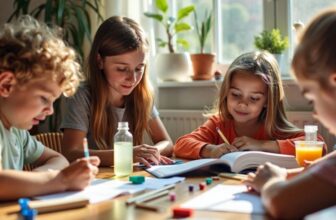
Engaging children in creative educational activities is not only a way to keep them entertained but also an opportunity to foster their development in critical thinking, problem-solving, and a love for learning. By integrating educational elements into play and providing a variety of stimulating experiences, parents and educators can help children explore their creativity while learning new concepts. This article delves into various strategies and activities that can make learning fun and impactful for kids of all ages.
Key Takeaways
- Creative play can be educational by integrating learning concepts such as colors, shapes, and numbers, and by encouraging curiosity and experimentation.
- Designating a creative space and rotating activities can maintain children’s interest and promote sustained engagement in learning through play.
- Budget-friendly creative projects can be crafted from upcycled household items, nature-inspired materials, and common ingredients for DIY science experiments.
- Educational games, including interactive memory and mind games, storytelling, and puzzles, make learning enjoyable and help develop literacy and numeracy skills.
- Technology, when used wisely, can enhance creative learning through educational apps, virtual field trips, and by introducing coding and robotics in a playful manner.
Incorporating Learning into Creative Play

Blending Education with Arts and Crafts
Arts and crafts offer a vibrant canvas for children to learn and express themselves. By integrating educational elements into these activities, kids can explore concepts such as colors, shapes, and numbers in a hands-on way. For instance, while creating a collage, children can sort materials by color or shape, reinforcing their understanding of these concepts.
Creativity in education isn’t just about the end product; it’s about the process. Encourage your children to ask questions and make observations as they work on their projects. This nurtures their curiosity and analytical skills.
- Have children label parts of their artwork to practice spelling and vocabulary.
- Use measuring tools in crafting to teach basic math skills.
- Incorporate storytelling by asking kids to narrate the story behind their creation.
Encouraging children to explain their artistic choices can deepen their critical thinking and communication skills.
Remember, the goal is to make learning enjoyable and organic within the realm of creative play. By doing so, you’ll help your children develop a love for learning that extends beyond the classroom.
Educational Role-Playing Scenarios
Role-playing scenarios are a dynamic way to blend education with imaginative play. By stepping into different roles, children can explore various subjects in a context that feels exciting and relevant. Create scenarios based on historical events or scientific discoveries to allow kids to live through the lessons they’re learning.
- Modify classic games* like Simon Says or Pictionary to include academic content. For example, in Simon Says, use commands related to math problems or language arts concepts. In Pictionary, draw items from a word bank tied to the current curriculum.
- Encourage children to act out professions, such as doctors, engineers, or artists, to understand these roles better.
- Set up a mock marketplace to teach economics and the value of money.
- Design a courtroom drama to explain the judicial system and civic responsibility.
By engaging in role-play, children develop empathy and social skills while learning. It’s an effective way to make abstract concepts tangible and memorable.
Remember, the key is to keep the scenarios flexible and open-ended to encourage problem-solving and critical thinking. This approach not only makes learning more enjoyable but also helps to reinforce the material in a practical, hands-on manner.
Learning Through Cooking and Baking Adventures
Cooking and baking with children is a delightful way to blend education with hands-on experience. Engaging kids in the kitchen helps them learn valuable life skills while they have fun creating and tasting their own culinary masterpieces. Here are some ways to turn cooking and baking into educational adventures:
- Start with simple recipes that allow children to be involved in the process, such as measuring ingredients, mixing, and decorating.
- Discuss the importance of food safety and proper hygiene while cooking.
- Use the opportunity to teach about nutrition and the benefits of different foods.
- Encourage them to experiment with flavors and textures, fostering creativity and sensory exploration.
Plus, they get to enjoy the fruits of their labor by tasting the delicious dishes they helped create.
Remember, the key is to make the experience enjoyable and stress-free. Allow for a little mess and be patient as they learn. The skills and memories they gain from cooking and baking adventures will last a lifetime.
Maximizing Engagement in Creative Activities

Designing a Dedicated Creative Space
Creating a dedicated creative space for your children can significantly enhance their engagement and willingness to explore their artistic and intellectual interests. A well-organized and inviting space can inspire kids to spend more time on creative activities, from arts and crafts to educational games.
- Choose a location that is quiet and free of distractions, yet accessible.
- Equip the space with a variety of materials, such as paper, markers, and building blocks.
- Ensure the area is safe and age-appropriate, with easy-to-clean surfaces.
By providing a special spot in the home specifically for creative endeavors, children are more likely to feel motivated and take ownership of their projects. This autonomy fosters a deeper connection with their activities and a stronger desire to learn.
Remember to involve your children in the setup process. Allowing them to personalize their space with their own decorations or artwork can make it feel truly theirs. Encourage them to maintain the area, which can teach responsibility and organizational skills. Rotating materials and introducing new challenges will keep the space fresh and exciting, ensuring that their creative journey continues to evolve.
Rotating Activities to Sustain Interest
Keeping children engaged over time can be a challenge, but rotating activities is a key strategy to maintain their interest. By introducing new activities regularly, you can help prevent boredom and stimulate continuous learning. Here are some tips to effectively rotate activities:
- Introduce a new activity every week to keep the curiosity alive.
- Keep a balance between educational and purely fun activities.
- Observe your child’s response to different activities and adjust the rotation accordingly.
It’s important to remember that each child is unique. What excites one child may not interest another, so customization is crucial.
Encouraging children to anticipate what’s coming next can also be a powerful motivator. Let them know that after mastering one activity, they’ll get to try something completely different. This approach not only keeps them engaged but also builds a sense of accomplishment and eagerness to learn.
Encouraging Self-Directed Exploration
Self-directed exploration is a cornerstone of creative education, allowing children to follow their curiosity and learn at their own pace. Fostering a love for learning through unstructured play, kids develop a natural inclination to ask questions and seek answers. This autonomy supports cognitive development and cultivates a lifelong journey of discovery.
Outdoor exploration is an excellent way to engage children with the natural world. Consider these activities to encourage self-directed learning:
- Nature walks or hikes to observe local flora and fauna
- Scavenger hunts for natural items like leaves, rocks, or flowers
- Collecting objects from nature for art projects or further study
Encouraging children to take ownership of their play experiences allows them to set goals and manage their time, emotions, and behavior. This independence is crucial for self-regulation and personal growth.
Physical activity is an integral part of self-directed exploration. Activities that involve running, jumping, and climbing not only promote physical health but also help in developing gross motor skills and spatial awareness.
Budget-Friendly Creative Projects

Upcycling Household Items for Art
Turning everyday household items into art projects is not only a fun and creative way to engage your kids, but it’s also a fantastic method to teach them about sustainability and resourcefulness. Start by gathering materials that would otherwise be discarded, such as cardboard boxes, plastic bottles, and old magazines.
- Create a bottle airplane using empty plastic bottles, glue, and colorful paper.
- Transform cardboard boxes into imaginative playhouses, vehicles, or even robots.
- Old magazines can be cut up to make vibrant collages, or used in a decoupage project on items like picture frames or storage boxes.
Encouraging your children to see the potential in these everyday items fosters creativity and an innovative mindset. It’s a hands-on way to learn about recycling and the importance of reducing waste. By upcycling, kids can take pride in creating something beautiful and functional from materials that would otherwise be thrown away.
Nature-Inspired Crafts and Exploration
Engaging children in nature-inspired crafts and exploration is a delightful way to foster creativity and an appreciation for the environment. Encourage your kids to collect natural items such as leaves, rocks, or flowers during outdoor activities like nature walks or scavenger hunts. These items can become the foundation for a variety of artistic projects.
- Collect leaves of different shapes and sizes to create a leaf collage.
- Paint rocks to make colorful garden markers or story-telling stones.
- Press flowers to make bookmarks or decorate homemade cards.
Incorporating these natural elements into crafts not only stimulates the imagination but also provides a hands-on learning experience about the diversity of our ecosystem. As they create, children can learn about the characteristics of different plants and animals they encounter.
By integrating art with environmental exploration, kids develop a deeper connection with the world around them, gaining both artistic skills and ecological awareness.
DIY Science Experiments with Common Ingredients
Unlock the wonders of science right in your kitchen with DIY experiments that are as entertaining as they are enlightening. Engage your children’s natural curiosity by transforming common household items into tools of discovery. For instance:
- Create a homemade volcano with the classic reaction between baking soda and vinegar.
- Mix up a batch of homemade slime using glue, shaving cream, and saline solution.
- Fashion a lava lamp with oil, water, food coloring, and Alka-Seltzer.
These activities not only demonstrate scientific principles but also encourage hands-on learning and problem-solving. Remember to prioritize safety and supervise your kids, especially with experiments that involve chemical reactions.
Encouraging your kids to hypothesize what will happen during each experiment fosters a scientific mindset and turns playtime into an impromptu science lesson.
Educational Games that Make Learning Fun

Interactive Memory and Mind Games
Memory and mind games are not just entertaining; they are a powerful tool for enhancing cognitive skills in children. Engage your kids with memory games that challenge them to remember and match pairs, boosting their focus and recall abilities. For instance, using picture cards for a game of Concentration can be both fun and educational. Shuffle the cards, lay them face down, and have the kids find matching pairs. To add a competitive edge, turn it into a mini-memorization contest with a small reward for the winner.
Simon Says and Pictionary can be adapted to be more interactive and educational. For example, in Simon Says, include actions that reinforce vocabulary or concepts they’ve learned. With Pictionary, use words related to their current studies to promote quick thinking and reinforce learning.
Encouraging children to play these games regularly can significantly improve their memory and problem-solving skills.
Here are a few simple steps to create an engaging memory game:
- Choose a subject or theme for the flashcards.
- Prepare a set of flashcards with relevant images or words.
- Explain the rules and objective of the game to the children.
- Start the game and observe as they exercise their brains to remember and match.
Remember, the key is to make the learning process enjoyable so that children look forward to these educational playtimes.
Building Literacy with Storytelling Activities
Storytelling is a powerful tool for building literacy in children, allowing them to expand their vocabulary and comprehension in a fun and engaging way. Encourage your kids to create their own stories, which can help them understand narrative structure and develop their creativity.
- Start by reading a variety of stories together.
- Discuss the characters, setting, and plot to inspire their imagination.
- Provide prompts or story starters to help them begin their own tales.
Imagination is key in storytelling activities. By allowing children to dictate their stories, you can write them down and later read them back, which reinforces their learning and gives them a sense of accomplishment.
Encouraging children to share their stories with others can boost their confidence and enhance their communication skills.
Remember, the goal is to make learning enjoyable, so keep the atmosphere light and praise their efforts. This not only builds literacy but also nurtures a lifelong love for reading and writing.
Mathematics Through Play: Numbers and Puzzles
Introducing mathematics through play can transform the way children perceive numbers and problem-solving. Games like ‘Math Quiz’ engage kids in a fun and competitive environment, encouraging them to use their quantitative abilities. This approach is particularly effective as it steers away from the traditional reliance on electronic calculators.
To set up a Math Quiz, simply gather a collection of math questions, ensuring they are clear and relevant to real-life scenarios. During the game, give each team a minute to solve a problem, fostering a sense of urgency and excitement.
Here’s a quick guide to get started:
- Prepare a set of math questions of varying difficulty.
- Organize the children into small teams of four to eight participants.
- Provide paper and pen for scorekeeping.
- Pose the questions to the teams and let the fun begin!
Remember, the key is to make the experience enjoyable. Incorporate puzzles and games that require critical thinking, such as ‘What’s Missing?’ where children recall and identify missing elements from a set of flashcards. By blending learning with playful activities, children are more likely to develop a lasting interest in mathematics.
Harnessing Technology for Creative Learning

Educational Apps and Online Resources
In the digital age, harnessing the power of technology can transform the way children learn. Educational apps and online resources offer a treasure trove of interactive experiences that cater to various interests and learning styles. From language learning to mathematical puzzles, the options are virtually limitless.
- Educational games cover subjects like science, math, English, arts, music, and history.
- They not only entertain but also build social, cognitive, and logical skills.
- Online platforms provide a diverse range of games, from simple trivia to complex simulations.
When selecting educational apps for your children, look for those that balance fun with informative content. It’s essential to choose apps that are age-appropriate and align with your child’s educational needs. Encourage your kids to explore different apps and games to find the ones that excite them the most, fostering a love for learning that goes beyond the classroom.
By integrating educational technology into your child’s playtime, you open up a world of possibilities for creative learning and development.
Virtual Field Trips and Cultural Experiences
In an age where technology bridges gaps across continents, virtual field trips offer an unparalleled opportunity for children to explore the world from the comfort of their home. These digital excursions allow students to visit museums, historical sites, and natural wonders, providing a rich cultural experience without the need for physical travel.
Virtual field trips can be both an educational and entertaining way to engage with diverse cultures and environments. Here are some steps to maximize the experience:
- Choose a destination that aligns with your child’s interests or current learning topics.
- Prepare interactive activities or questions to encourage active participation during the trip.
- Follow up with a creative project or discussion to reinforce what they’ve learned.
Embracing technology in education doesn’t mean replacing traditional learning methods; it means enhancing them to create a more dynamic and inclusive learning environment.
Remember, the key to a successful virtual field trip is engagement. Encourage your child to ask questions, take notes, and truly immerse themselves in the experience. By doing so, they’ll gain a deeper understanding and appreciation for the world’s vast cultural tapestry.
Incorporating Coding and Robotics in Play
Introducing children to coding and robotics through play can be a transformative experience, fostering not only a love for technology but also enhancing their problem-solving skills. Start with simple programmable robots or coding games that teach the basics of algorithms and logical thinking.
- Begin with age-appropriate coding toys or apps
- Progress to more complex projects as skills develop
- Encourage collaboration on coding challenges
Incorporating robotics into play allows children to see the tangible results of their coding efforts. They learn the cause and effect relationship between the code they write and the robot’s actions. This hands-on approach demystifies technology and empowers kids to become creators, not just consumers.
By integrating coding and robotics into playtime, children can develop critical thinking and gain a foundational understanding of how technology works. This knowledge is crucial in today’s digital world and can spark a lifelong interest in STEM fields.
Conclusion
In wrapping up, the plethora of creative educational activities available can significantly contribute to your child’s development and engagement. From incorporating basic learning concepts into playful activities to setting up a stimulating creative space, the options are endless and adaptable to any budget. Remember, the key to keeping your kids engaged is to fuel their natural curiosity and love for exploration. By doing so, not only do we make education enjoyable, but we also foster essential skills such as problem-solving, critical thinking, and communication. So, let’s embrace these creative endeavors and watch our children grow into confident, imaginative learners. Whether it’s through crafting, baking, or playing memory games, every moment of fun can be a valuable learning experience.
Frequently Asked Questions
How can I make creative activities educational for my kids?
You can make creative activities educational for your kids by incorporating learning concepts like colors, shapes, numbers, and letters into the activities. Additionally, you can encourage them to ask questions, make observations, and experiment with different techniques.
What are some benefits of engaging kids in creative activities?
Engaging kids in creative activities can help them develop important skills like problem-solving, critical thinking, fine motor skills, and communication skills. Creative activities also allow kids to express themselves, build confidence, and foster a love for learning and exploration.
Are there any creative activities that are budget-friendly?
Yes, there are many budget-friendly creative activities such as upcycling household items for art projects, exploring nature and creating crafts with found objects, and conducting DIY science experiments with common household ingredients.
What are some creative activities to keep kids entertained?
Some creative activities to keep kids entertained include painting, crafting, baking, building with Legos, and creating a scavenger hunt.
How can I engage my child at home without using toys?
You can engage your child at home without toys by involving them in interactive activities like arts and crafts, reading together, playing memory and mind games, or participating in cooking and baking adventures.
Why do kids get bored so easily and how can I keep them engaged?
Kids get bored easily due to their natural curiosity and need for stimulation. To keep them engaged, provide a variety of materials and activities, set up a dedicated creative space, and encourage self-directed exploration and new challenges.






